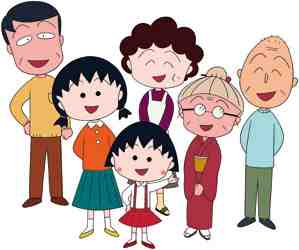Chibi Maruko-chanFrom Wikipedia, the free encyclopedia
| Chibi Maruko-chan | |
Cover of the first volume by Shueisha
| |
| ちびまる子ちゃん (Chibimarukochan) | |
|---|---|
| Genre | Slice of life story |
| Manga | |
| Written by | Momoko Sakura |
| Published by | Shueisha |
| Demographic | Shōjo |
| Magazine | Ribon |
| Original run | August 1986 – April 2009 |
| Volumes | 16 |
| Anime television series | |
| Directed by | Yumiko Suda Tsutomu Shibayama |
| Studio | Nippon Animation |
| Network | Fuji Television, Animax |
| English network | Animax Asia |
| Original run | January 7, 1990 –September 27, 1992 |
| Episodes | 142 |
| Anime film | |
| Chibi Maruko-chan: My Favorite Song | |
| Released | December 19, 1992 |
| Runtime | 93 minutes |
| Anime television series | |
| Studio | Nippon Animation |
| Network | Fuji TV, Animax |
| Original run | January 8, 1995 – ongoing |
| Episodes | 918 (as of August 25, 2013) |
| Television drama | |
| Chibi Maruko-chan (live-action special) | |
| Network | Fuji TV |
| Original run | April 18, 2006 –October 31, 2006 |
| Episodes | 2 |
| Television drama | |
| Marumaru Maruko-chan | |
| Network | Fuji TV |
| Original run | April 19, 2007 –February 28, 2008 |
| Episodes | 31 |
The first story under the title "Chibi Maruko-chan" was published in the August 1986 edition of the shōjo manga magazine Ribon. Other semi-autobiographical stories by the author had appeared in Ribon and Ribon Original in 1984 and 1985, and were included in the first "Chibi Maruko-chan"tankōbon in 1987. The author first began writing and submitting strips in her final year of senior high school, although Shueisha (the publisher of Ribon and Ribon Original) did not decide to run them until over a year later. The author's intent was to write "essays in manga form".[1] Many stories are inspired by incidents from the author's own life, and some characters are based on her family and friends. The nostalgic, honest and thoughtful tone of the strip led to its becoming popular among a wider audience.
The Chibi Maruko-chan series has spawned numerous games, animated films and merchandising, as well as a second TV series running from 1995 to the present. Maruko's style and themes are sometimes compared to the classic comic Sazae-san. In 1989, the manga tied to receive theKodansha Manga Award for shōjo.[2] As of 2006, the collected volumes of the manga had sold more than 31 million copies in Japan, making it the fifth best-selling shōjo manga ever.[3]Contents The trademark
The trademark face fault of this series, the manga and anime and drama all, in reaction to an awkward "don't know what to say" situation (or sometimes, embarrassment) is the sudden appearance of vertical lines (黒い線 kuroi sen) on a character's face, sometimes with an unexplained gust of wind blowing above that character's head.
Sakura family


Momoko "Maruko" Sakura (さくらももこ Sakura Momoko, まる子 Maruko)
Voiced by: Tarako, Live-Action: Ei Morisako
The title character, Maruko (born May 8, 1965) is a nine-year-old third-grade student raised in a relatively poor family of six. She is lazy, disorganized and usually late for school, in strong contrast with her neat, calm and tidy older sister (sixth-grader) who must share her room with her. Maruko, like many kids, tries to avoid homework and chores, and she takes advantage of her doting grandfather and squabbles with her sister. Nevertheless, she is a well-meaning child who tries to do good. She is similar to Calvin in Calvin and Hobbes in that she often uses adult-like language to express her child-like feelings. She has many food dislikes, including natto and tomatoes. She loves reading manga and is a good artist, and her stated goal is to become a manga artist when she grows up. In one episode, she admired and aspired to be like Helen Keller, Mother Theresa, and Marie Curie. It is implied that the show is drawn by Maruko herself. Maruko has a problem with her sister cooking and throws whirlwind tantrums. She knows a lot about her mother, father and grandmother.

No comments:
Post a Comment